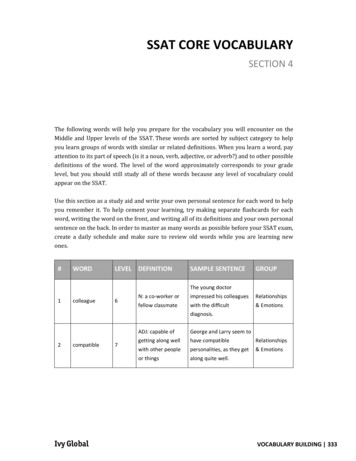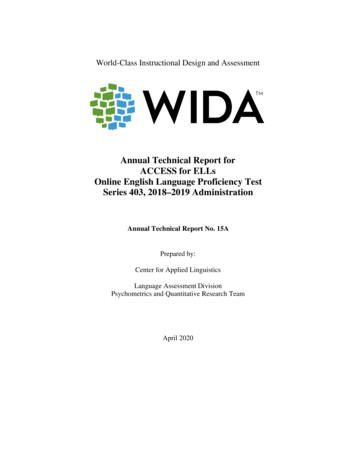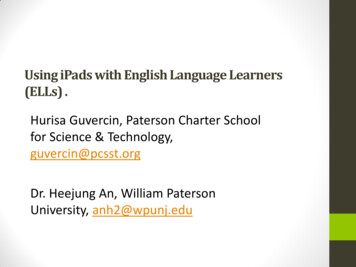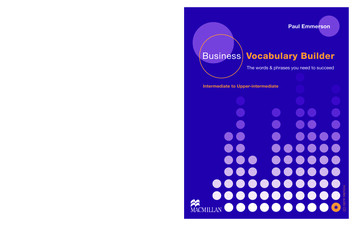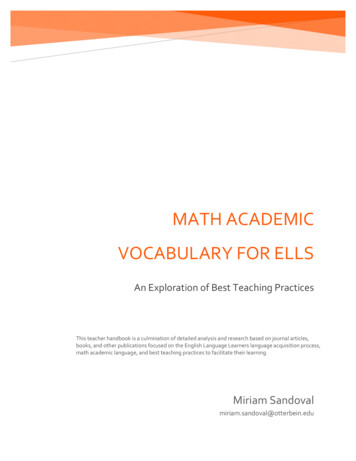
Transcription
MATH ACADEMICVOCABULARY FOR ELLSAn Exploration of Best Teaching PracticesThis teacher handbook is a culmination of detailed analysis and research based on journal articles,books, and other publications focused on the English Language Learners language acquisition process,math academic language, and best teaching practices to facilitate their learning.Miriam Sandovalmiriam.sandoval@otterbein.edu
MATH ACADEMIC VOCABULARY FOR ELLSTable of Contents. 1Overview . 3English Language Learners . 4Stages of Language Acquisition . 4Pre-functional – Pre-production or “the silent period” . 4Beginner . 4High Beginner. 4Intermediate.5Advanced .5Types of languages.5BICS - Basic Interpersonal Communicative Skills .5CALP – Cognitive Academic Language Proficiency .5Important definitions . 6Standards at a Glance . 9ELP Standards . 9Mathematics Standards . 10Mathematical Practices . 11Mapping ELP Standards and Math Practices . 12Vocabulary List . 13Instructional Strategies . 19Helpful Resources and Websites .222
MATH ACADEMIC VOCABULARY FOR ELLSOverviewThe fastest-growing student population in U.S. schools today are children of recentimmigrants, half of whom do not speak English fluently and are thus labeled EnglishLanguage Learners (ELLs) (Calderon, Slavin, & Sanchez, 2011). Although the federalgovernment requires schools and school districts to provide services to ELLs, it statesno consistent policies that must be followed in identifying, assessing, placing, orinstructing them (Calderon, Slavin, & Sanchez, 2011). English language learners are avery diverse group of students but they all face the same academic challenge; theymust learn the English language at the same time they are learning the academiccontent in all the different subject areas in an unfamiliar language.In my school district, ELLs represent 8.9% of the student population. This numberrepresents 1,380 ELL students district-wide. These ELLs are a diverse group of studentscoming from 57 different countries and speaking 47 different languages from aroundthe world. About 126 ELL students are enrolled at my high school (Facts at a Glance,2017). When they start high school, they are placed in classes based on their Englishknowledge and the OELPA assessment results (English Proficiency Test). They receivesheltered English, History, Science, Algebra and Geometry classes based on theiracademic achievement in content, previous background knowledge, years of schooling,past grades, and state tests results.This teacher handbook presents and shares important definitions, instructional tips,and best teaching practices that will help first time teachers or teachers who are havingtheir first experience working with ELLs to be better informed and prepared. Thecreation of this teacher handbook is the results of researching and summarizing whatresearch states are the best teaching practices to facilitate the learning of mathacademic language while learning English.3
MATH ACADEMIC VOCABULARY FOR ELLSEnglish Language LearnersThe Ohio Department of Education establishes and implements statewide guidelinesand procedures for the identification of ELLs. The first step in this process consists ofadministering a Home Language Survey at enrollment time. This survey identifieslanguage backgrounds other than English spoken at home for all students enrolling ingrades Pre-K-12. It is important to mention that place of birth is only a secondaryfactor in this identification process. English Language Learners may either be bornoutside the US or within it. The student is then assessed for English LanguageProficiency in reading, writing, listening and speaking skills by qualified screener (ODEwebsite, 2017).Stages of Language AcquisitionThe Ohio Department of Education classified the stages of language acquisition byELLs as well as the different types of languages used for these ELLs and the type oflearners we can have in our classrooms. These are the classifications of ELLs by thestages of language acquisition:Pre-functional – Pre-production or “the silent period”New students just listen. Some may not speak for weeks or months. Don’t force them.Some will start using simple learned phrases and simple sentences.BeginnerStudents will develop a vocabulary of about 1,000 words; speak in one or two-wordphrases, memorized chunks and simple sentences. This may last about 6 months.High BeginnerStudents will develop a vocabulary of about 3,000 words, use simple sentences, asksimple questions, read easy stories, and write simple sentences.4
MATH ACADEMIC VOCABULARY FOR ELLSIntermediateNow students have a 6,000-word vocabulary, use more complex sentences, and askquestions. They will still have grammar errors.AdvancedIt can take 4 – 10 years to achieve this. Students are able to cope in the classroom butwill still need help with vocabulary, idioms, writing and content such as mathematicsand social studies.Types of languagesThe ODE (ODE Website, 2017) suggests that classroom teachers need to consider notonly the stages of language acquisition when working with English learners but also thedifference between social and academic language. Based on research conducted byELL experts such as Jim Cummins, it is important to differentiate between social andacademic language when working with ELLs. These two types of languages are:BICS - Basic Interpersonal Communicative SkillsThis is social language and develops in 1 to 3 years. This is the day-to-day languageneeded to interact with other people. This language is context based and ELLs useBICS on the playground, in the cafeteria, on the bus and in other social settings.CALP – Cognitive Academic Language ProficiencyThis is academic language and takes 5- 7 years to develop. These are general academicwords and content specific words. Academic language is decontextualized and ofteninvolves large and uncommon words.5
MATH ACADEMIC VOCABULARY FOR ELLSImportant definitionsAccommodationsChanges of language or written language to make comprehensible for ELLs.AdaptationsModifications in materials and instruction made for ELLs.Background KnowledgeAlso called prior knowledge, this term refers to the background experience andknowledge that students bring to the classroom.Bilingual ParaprofessionalESL staff who collaborate with licensed staff, support and assist ELLs with secondlanguage and second culture families as needed.Comprehensible InputIt is language input that can be understood by listeners despite them not understandingall the words and structures in it. Students being able to understand the essence ofwhat is being said or presented to them.Co-teachingA teaching approach whereby an ESL and general classroom teacher shareresponsibility for co-planning and co-delivering instruction in a general educationclassroom.ELLEnglish Language Learners refer to those students whose native or home language isother than English, and whose current limitations in the ability to understand, speak,read or write in English limits their effective participation in a school’s educational6
MATH ACADEMIC VOCABULARY FOR ELLSprograms. This term is often preferred over Limited English Proficiency (LEP) as ithighlights accomplishments rather than deficits.ESL TeacherDevelops students’ social and academic English language skills (reading, writing,listening, and speaking) using State Standards. Requires a TESOL (Teachers of Englishto Students of Other Languages) endorsement to existing license.Interpreter“Interpreter” and “translator” are often used interchangeably, but they have differentmeanings. An interpreter conveys information from one language to another orally. Atranslator conveys information in the written form.MainstreamThe placement of ELLs in regular education classes in which the language of instructionis the dominant language.OELPAOhio English Language Proficiency Assessment (OELPA). Administered to all identifiedELLs in Ohio. This test determines each student’s level of English proficiency and is thebasis for exit from an ESL program.Parent RefusalParents decline ESL services for which children qualify. Students are placed inmainstream programs without ESL support. In Ohio, students remain eligible foraccommodations on statewide tests and must take the OELPA test until exit from theESL program.Push-outA teaching arrangement whereby a teacher or specialist takes small groups of studentsfrom the mainstream classroom for part of the school day to provide specializedsupport.7
MATH ACADEMIC VOCABULARY FOR ELLSPush-inA teaching arrangement whereby a teacher or specialist join the mainstream classroomto give specialized support to a small number of students or to help the generaleducation/content teacher improve content instruction for ELLs.RealiaReal life objects that are used as visuals in language instruction.ScaffoldingThe use of temporary supports that help ELLs comprehend information as they developEnglish language.SIOPSheltered Instruction Observation Protocol. A program model for teaching grade-levelcontent in a way that is understandable for ELL students while at the same timepromoting their English language development.TPRTotal Physical Response. Instruction that provides opportunities for students to developlanguage and conceptual understanding by physically doing an activity or engaging inthe concept being taught.8
MATH ACADEMIC VOCABULARY FOR ELLSStandards at a GlanceELP StandardsThe English Language (ELP) Standards 1 developed for k-12 by the Ohio Department ofEducation highlights the necessary language skills and knowledge that ELLS need to besuccessful in schools and meet the college and career ready standards.ELP consists of 10 standards that describe a set of language functions (what studentsdo with language to accomplish content-specific tasks) and language forms(vocabulary, grammar, and discourse specific to a particular content area or discipline)that are needed by English language learners as they develop competence in Englishlanguage arts and literacy, mathematics, and science.1. Construct meaning from oral presentations and literary and informational textthrough grade-appropriate listening, reading, and viewing2. Participate in grade-appropriate oral and written exchanges of information,ideas, and analyses, responding to peer, audience, or reader comments andquestions3. Speak and write about grade-appropriate complex literary and informationaltexts and topics4. Construct grade-appropriate oral and written claims and support them withreasoning and evidence1Source Ohio Department of Education: s/ELP-Content-Standards-20150824.pdf.aspx9
MATH ACADEMIC VOCABULARY FOR ELLS5. Conduct research and evaluate and communicate findings to answer questionsor solve problems6. Analyze and critique the arguments of others orally and in writing7. Adapt language choices to purpose, task, and audience when speaking andwriting8. Determine the meaning of words and phrases in oral presentations and literaryand informational text9. Create clear and coherent grade-appropriate speech and text10. Make accurate use of standard English to communicate in grade-appropriatespeech and writingThe ELP Standards can also be framed in relation to narrower domains of listening,speaking, reading, and writing and also in relation to broader receptive, productive, andinteractive modalities. (See mapping table)Mathematics StandardsMathematics content standards2 define what students should understand and be ableto do in their study of mathematics. The content standards are grade-specific but donot define the intervention methods or materials necessary to support students whoare well below or well above grade-level expectations. It is also beyond the scope of theStandards to define the full range of supports appropriate for English language learnersand for students with special needs.2Source Ohio Department of Education: -in-Mathematics/Math-Standards.pdf.aspx10
MATH ACADEMIC VOCABULARY FOR ELLSThe Standards for Mathematical practice describe varieties of expertise thatmathematics educators at all levels should seek to develop in their students. There areeight standards for mathematical practice.Mathematical Practices1. Make sense of problems and persevere in solving them.2. Reason abstractly and quantitatively.3. Construct viable arguments and critique the reasoning of others.4. Model with mathematics.5. Use appropriate tools strategically.6. Attend to precision.7. Look for and make use of structure.8. Look for and express regularity in repeated reasoning.11
MATH ACADEMIC VOCABULARY FOR ELLSMapping ELP Standards and Math PracticesListening andReadingSpeaking and WritingListening, Speaking, Readingand WritingInteractive ModalitiesProductive ModalitiesReceptiveModalitiesModalities DomainsELP StandardsMath Practices1. Construct meaning from oral presentations andliterary and informational text trough grade-appropriatelistening, reading, and viewingMP1 Make sense of problems and perseverein solving them.8. Determine the meaning of words and phrases in oralpresentations and literacy and informational textMP1 Make sense of problems and perseverein solving them.3. Speak and write about grade-appropriate complexliteracy and informational texts and topicsMP1 Make sense of problems and perseverein solving them.MP6 Attend to precision4. Construct grade-appropriate oral and written claimsand support them with reasoning evidenceMP3 Construct viable arguments andcritique reasoning of othersMP6 Attend to precision7. Adapt language choices to purpose, task, andaudience when speaking and writingMP6 Attend to precision2. Participate in grade-appropriate oral and writtenexchanges of information, ideas, and analysis,responding to peer, audience, or reader comments andquestionsMP1 Make sense of problems and perseverein solving them5. Conduct research and evaluate and communicatefindings to answer questions or solve problemsMP1 Make sense of problems and perseverein solving them6. Analyze and critique the arguments of others orallyand in writingMP1 Make sense of problems and perseverein solving themMP6 Attend to precisionMP3 Construct viable arguments andcritique reasoning of others12
MATH ACADEMIC VOCABULARY FOR ELLSVocabulary ListCreating an instructional program that promotes vocabulary instruction as a strategy to teach academic language to ELL studentsis crucial to the success of their math content and academic language learning. Learning academic vocabulary requires more thanjust learning conversational language because this academic language is more specific and sometimes abstract, making it difficultto grasp by ELLs. Here is a list of some of the vocabulary words that I believe should be included in any vocabulary instructionalprogram in the math classroom, especially before and during Algebra instruction. This list is organized in 4 levels and they arebased on the book Building Academic Vocabulary Teacher’s manual by Marzano and Pickering (2005).Level 1Level 2Level 3Level 4Above2-dimensional shape3-dimensional shapeAbsolute valueAdditionAcute angleAddition of fractionsAccelerationAreaAddendAlgebraic expressionAdd radical expressionsBehindAddition algorithmAlternate interior angleAdditionBelowAngleAngle bisectorAlgebraic functionBetweenAngle unitArea modelAngle depressionCardinal numberAreaArrayArcChanceAssociative propertyAxis of symmetryAreaCircleBar graphCircle formulaAsymptote of functionCoinBasic number combinationsCircumference formulaBinary systemDecreaseCapacityCombining like termsCartesian coordinates13
MATH ACADEMIC VOCABULARY FOR ELLSLevel 1Level 2Level 3Level 4DifferenceCentimeterComplementary angleCentral angleDirectionCircumferenceComposite numberChordEstimateClasses of triangleCongruenceCircleFoot (measurement)ClusterConjectureCircularGraphCommon denominatorConstant differenceClasses of functionsGreater thanCommon fractionsConstant rate of changeCombinationGroupingCommutative propertyConstant ratioCompound interestGuess and checkConstantConvertConditionalHeightCorresponding anglesCoordinateContinuousHourCorresponding sidesCounter exampleControl groupIn frontCubeCountingCorrelationInchCylinderCube numberCosineIncreaseDataCube rootCurveInsideData collectionCubic eductiveDiscreteLess thanDifferentDefiningDivideLocationDistributive propertyDilationDivide radical expressionsMeasuring cupDividendDistanceDomain functionMinuteDivisibilityEnlarging transformationEquivalentModelDivisionEqual ratiosExpected valueMoneyEquationEquationExponentNearEquilateral triangleExperimentExponential function14
MATH ACADEMIC VOCABULARY FOR ELLSLevel 1Level 2Level 3Level 4NumberEquivalent fractionsExponentFactorialNumber lineEstimationExponential notationFinite graphNumeralEven numbersFair chanceFractionNumeric patternEvent likelihoodFrequencyFunction notationOrdinal numberExpanded notationGraphic representation ofGeometric functionOrientationExtreme valuefunctionImaginary numberOutcomeFactorsGrowth rateIsometryOutsideFractionInput/output tableLaw of ic patternInterceptLine equationPredictionGreatest common factorIntercepting linesLine segmentRectangleGrowing patternIrregular polygonLine segment congruenceRightHistogramLarge sampleLine segment similarityRulerHorizontal axisLine symmetryLinearSecond (time)Identity patternLinear arithmetic sequenceMinimum/maximum of functionSetImproper fractionLinear equationMonomialShapeInequalityMathematical expressionMultiply radical expressionsSimilarityIntersectionMaximumNatural numberSizeIrrelevantMinimumNegative exponentSquareIsosceles triangleMultipleParallelSubtractionLess common multipleNumber propertyPiSumLine graphOddsPolynomialTableLinear patternOrdered pairsPostulate15
MATH ACADEMIC VOCABULARY FOR ELLSLevel 1Level 2Level 3Level 4TemperatureMassParallel ractorVolumeMeterPlanePythagorean theoremWeekMetric systemPolygonRadical expressionWhole numberMidpointPrime factorRadiusWidthMixed numbersProblemRange of functionYearModeProjectionRational functionZeroMultipleProportionalReal numbersMultiplicationQuadratic equationReciprocalSome words needed toNegative numberQuadrilateralRecursiveunderstand mathNumber of facesRandomReflectionproblems:Number pairsRangeRegressionNumber sentenceRateRelativeAnalyzeObtuse angleRational numberRight triangleAnswerOdd numbersRectangleRoots and real numbersCompleteOrder of operationsRectangularRotationDescribeParallel linesRecursive sExaminePart to wholeRootSimilarExplainPatternRotation symmetrySimilar figuresFindPercentSampleSpeed16
MATH ACADEMIC VOCABULARY FOR ELLSLevel 1Level 2Level 3Level ar linesScatter plotStatisticMarkPie chartScientific notationStrategyObservePositive numberSequenceSubtractResolvePrime factorizationSimilarSummaryRulerPrime numberSimilarity vs. congruenceSurface areaSolvePrismSimplificationSystems of equationsStudyProbabilitySlopeSystems of inequalitiesSurveyProcess of eliminationSlope intercept formulaTangentProductSolid figureTermProofSolutionTheoremPyramidSquare numberTransversalQuotientSquare rootTrigonometricRectangleSquare unitsTwo-way tablesRectangle prismSubstitutionUnitReduced formSupplementary angleVectorRelative distanceTable representationVelocityRelevant informationThermometerVertexRemainderTrapezoid formulaRepeating patternTree diagram modelRestate a problemTriangle sidesRhombusUnderestimationRight angleUnit size17
MATH ACADEMIC VOCABULARY FOR ELLSLevel 1Level 2Level 3RotationVariableRoundingVertexSame size unitsVolume formulaSampleVolume of cylinder, prism, andScalepyramidShapeWork backwardSphereWritten representationLevel 4StandardStudiesSubtractionSurface areaSurveySymbolic representationsTalliesTime zoneTriangle formulaUnitUnlike termsVenn diagramVerificationVertical axisVolume18
MATH ACADEMIC VOCABULARY FOR ELLSInstructional StrategiesThe following tables include a series of teaching strategies and suggestions thatrepresent the culmination of comprehensive research on how to integrate instructionalstrategies used during English instruction into the math content class in order tofacilitate the teaching of mathematics academic and vocabulary content to ELLs. Theserecommended best practices and strategies have been summarized in the below chartsbased on the following categories:1. Teacher Knowledge and Understanding, including second languageacquisition, math academic language and vocabulary knowledge.2. Teacher Planning and Organization, including planning techniques, classroommanagement and room organization.3. Teacher Attitudes and Dispositions, including beliefs, attitudes, and awarenessKnowledge and Understandingof student background knowledge. Face your class when you are speaking to them Use simple sentence structure and vocabulary Minimize the use of idiomatic expressions Model or demonstrate directions Always speak in a normal tone (not louder) Avoid overstressing correct pronunciation and grammar Teach groups of words that are related together Remember it can take two to seven years for a non-English speaker toacquire academic language19
MATH ACADEMIC VOCABULARY FOR ELLS Simplify your language but not the concept when you are planning yourPlanning and Organizationlessons Announce and write objectives on the board State objective orally at the beginning of each lesson Review objectives at the end of each lesson Give students plenty of time to copy your notes Allow sufficient wait time or think time Write legibly, many ELLs cannot read cursive. Write in print Use the chalkboard or overhead projector to write important words and ideas Incorporate pictures and objects to teach new words and concepts Incorporate hands-on activities into each lesson Use objects like visuals displays, photos, and authentic materials such asnewspapers and magazines Use manipulatives to promote hands-on activities and understanding ofdifficult concepts Use real objects (realia) to help students understand Use graphic organizers to simplify the language (timelines, diagrams andwebs Label objects in the classroom in English Provide a list of directional words (write, read, underline, circle, match,add/subtract, trace, draw, cut) Summarize at the end of the day what was taught Use group assignments Reduce the number of test questions, simplify Design appropriate rubrics for assignments Allow students to demonstrate knowledge in drawings, posters, visualrepresentations20
MATH ACADEMIC VOCABULARY FOR ELLS Learn the student’s given name Never discourage parents from speaking with their student in their nativelanguage Never discourage student to speak their native language in the classroom.Attitudes and DispositionsEstablish common rules during instructional time Help student to feel part of the classroom Remember that some students have low levels of literacy and may not knowthe English alphabet Emphasize key words and phrases using intonation, repetition, and gestures Add elements of student’s culture in your writings (problems) Make information comprehensible (comprehensible input) Encourage student to indicate when he/she does not understand you Employ daily routines in classroom activities Post a schedule in the classroom or provide a picture schedule Check frequently for comprehension (ask questions, think pair-share, etc.) Instead of asking students “do you understand?” ask students to reword orexplain Avoid oral correction of language errors, instead model correct usage Consider giving ELL students a second chance to correct errors beforegrading21
MATH ACADEMIC VOCABULARY FOR ELLSHelpful Resources and WebsitesColorin Coloradohttp://www.colorincolorado.orgCPM Math ntU Educator esl-math/Free ot.comKhan Academyhttps://www.khanacademy.orgOhio Department of Educationhttps://education.ohio.govProdigy Mathhttps://www.prodigygame.comSAT Free Practicehttp://www.satfreepractice.comTen Markshttps://www.tenmarks.com22
Students will develop a vocabulary of about 1,000 words; speak in one or two-word phrases, memorized chunks and simple sentences. This may last about 6 months. High Beginner Students will develop a vocabulary of about 3,000 words, use simple sentences, ask simple questions, read easy stories, and write simple sentences.
